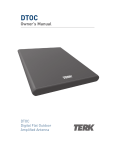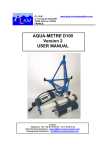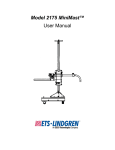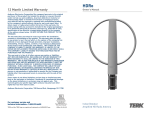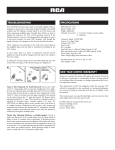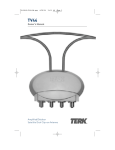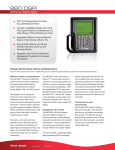Download Audiovox HDTVa - TV Antenna - Indoor Technical information
Transcript
Limited Warranty Audiovox Corporation (Audiovox) warrants this product against defects in materials or workmanship for one (1) year from the date of purchase. During this period, this product will be replaced without charge. This warranty does not cover any damage due to acts of nature, commercial use, accident, misuse, abuse or negligence. This warranty is only valid in the USA. Replacement as provided under this warranty is the exclusive remedy of the consumer. Audiovox shall not be liable for any incidental or consequential damages for breach of any express or implied warranty on this product, except to the extent that limitations of this sort are prohibited by applicable law. THERE ARE NO IMPLIED WARRANTIES OF MERCHANTABILITY OR FITNESS FOR A PARTICULAR PURCHASE EXCEPT TO THE EXTENT THAT IMPLIED WARRANTIES OR EITHER SORT ARE REQUIRED BY APPLICABLE LAW, AND IN SUCH CASE, EACH WARRANTY IS LIMITED IN DURATION TO THE ONE YEAR. For customer service and technical information:: 1.800.290.6650 TERK and the TERK logo are registered trademarks of AUDIOVOX Corp. For Customer Service Visit Our Website At www.audiovox.com Product Information, Photos, FAQ’s, Owner’s Manuals 44P008A HDTVo Owner’s Manual Indoor/Outdoor Amplified HDTV Antenna Safety Precautions HDTVo Warning! Use extreme caution when installing or removing an outdoor antenna that is located close to overhead wires such as power lines, telephone lines or cable TV lines. If any part of the antenna makes contact with overhead power lines, touching the antenna or the antenna cable can cause electrocution and death. If the antenna is in contact with any type of overhead wires, call your power company and ask them to send a qualified technician to remove the antenna. Do not attempt to remove it yourself! Important Safety Precautions... Many do-it-yourself and professional antenna installers are injured or killed each year by electric shock. While anyone can see the obvious danger of falling, the most resourceful sometimes fail to recognize overhead wires as being potentially lethal. To touch any part of the antenna to these overhead wires is the same as touching the wires with your bare hand. A very serious shock is almost sure to result when contacting an electrical wire, and in the case of primary wires on the top of poles, the shock is like being struck by a bolt of lightning. Many power wires are within 20 to 25 feet of the ground and could easily be touched by an assembled antenna. 1 HDTVo Please read and follow these important safety precautions: • Be sure to select an antenna site well away from all overhead wires. • Do not try to guess which overhead wires carry high voltage. Check with the Power Company. • If you notice anything making contact with the overhead wires, call the Power Company to have it removed safely. Do not run the downlead cable over power wires. • Get help from a qualified professional when removing the old antenna if there is any doubt of clearing overhead wires. • Never install the antenna outdoors at night, when it is windy, or during rain or snow. • Make sure the antenna installation is secure. • Do not stand on, lean on, hang from or hang anything on the antenna once it is mounted. Lightning Protection and Grounding Always plug your TV and other electronics devices into a quality surge protector for maximum protection against lightning and power surges. • Do not run the downlead cable over power wires. • Make sure the antenna downlead is connected to suitable lightning arrestors. All outdoor antenna installations should be properly grounded. To effectively protect the installation, the coaxial cable(s) should be grounded before they enter the house. The grounding of the coaxial cable is made using a “ground block” and copper wire (not supplied). For information and the materials needed to ground your antenna installation, visit your local electronics store. 2 About Your New TERK HDTVo Antenna HDTVo Your TERK HDTVo antenna is designed for both single and multifamily homes. It’s specifically engineered to provide superior reception of high-definition (HDTV), digital television (DTV) and VHF/UHF TV channels in most viewing locations. The HDTVo’s unique antenna technology and patented Dual-Mode integrated powered amplifier produce the clearest, cleanest signals available from a compact, unobtrusive design that blends well with any home decor. The HDTVo’s weatherproof, hermetically sealed housing offers ultra-reliable performance year after year. No assembly of the antenna is required. The HDTVo comes with all necessary mounting hardware for flexible placing indoors or outdoors. Your HDTVo Antenna Includes: (1) HDTVo Antenna (1) Power Injector with 110v AC to DC power adapter (1) Mini Mast (1) Mini Mast Bracket (1) Antenna Bracket (1) 3” partially threaded bracket bolt (1) 3/8” screw (4) 1.75” threaded bolts (4) washers (4) nuts (4) lag screws 3 HDTVo Fig 1. 4 Positioning the HDTVo HDTVo 5 The HDTVo MUST be mounted horizontally (See Fig 2.) with the front of the HDTVo precisely facing the direction of the TV station’s broadcasting transmitters. (See Fig 2.) The higher the elevation of the antenna, the better the reception performance will be. Pointing the Antenna Towards the Broadcast Tower 1. Go to www.terk.com and click on the “Antenna Locator” link. 2. Enter your home address and then “Submit.” 3. Click “View Street Level Map” to see in which direction you should face your antenna towards. HDTVo Right On the side of the house facing the broadcast tower Fig 2. Wrong Not on the side of the house facing the broadcast tower 6 Mounting the HDTVo Antenna HDTVo Mounting Options: For best performance, the HDTVo should be mounted outdoors in a high location (such as on the roof or high up on the side of your house). The HDTVo can also be mounted in an attic. Remember that the HDTVo is a highly directional antenna. As a result, it needs to be mounted with the front of the HDTVo precisely facing the direction of the TV station’s broadcasting transmitter. C Fig 3. A B The HDTVo can be mounted: –with the included bracket and the included mini-mast (This is the recommended option. Enables significantly adjusting the antenna’s positioning to fine-tune reception after installation.) OR – with the included bracket, but without the included mini-mast. OR – with the included bracket and a standard mast (not included). NOTE: Do not install the HDTVo on any metal surface, including aluminum siding. Mounting on a metal surface will seriously degrade reception quality. 7 WARNING: Never hang anything from the HDTVo; never attach foreign objects to the HDTVo. NOTE: If you are using the mini-mast, it is recommended that you first install the mini-mast at the desired location, and then attach the antenna to the mini-mast. HDTVo 8 To mount the HDTVo antenna on an outdoor wall using the minimast (see fig. 3A): 1. Locate the HDTVo antenna and all included components. 2. Using the four lag screws, attach the mini-mast bracket to the outdoor wall. Be sure to position the bracket vertically on the outdoor wall. 3. Slide the straight end of the mini-mast into the mini-mast bracket, and using the two nuts and the two bolts, secure the mini-mast to the mini-mast bracket. Be sure to orient the mini-mast as shown in the illustration 4. Using the four threaded bolts, the four washers and the four nuts, attach the antenna bracket and the pole clamp to the curved end of mini-mast. 5. Gently spread open the antenna’s two side reception elements. 6. Slide the back of the antenna into the antenna bracket. 7. Insert the 3” partially threaded bolt and the 3/8” screw into the holes on the top of the antenna bracket, and partially tighten the bolt. 8. With the 3” partially threaded bolt only partially tightened, adjust the antenna so that it is precisely pointing towards the broadcast tower (see “Positioning the HDTVo”). 9. Tighten the 3” partially threaded bolt and the 3/8” screw, securing the antenna in the antenna bracket. 10. Skip to the “Connecting the HDTVo to a TV” section to complete installation. To mount the HDTVo antenna on an outdoor wall without using the mini-mast (see fig. 3B): 1. Locate: – The HDTVo antenna – The four lag screws – The antenna bracket – The 3” partially threaded bolt and the 3/8” screw 2. Using the four lag screws, attach the antenna bracket to the outdoor wall. 3. Gently spread open the antenna’s two side reception elements. 4. Slide the back of the antenna into the antenna bracket. 5. Insert the 3” partially threaded bolt and the 3/8” screw into the hole on the top of the antenna bracket, and partially tighten the bolt. 6. With the 3” partially threaded bolt only partially tightened, adjust the antenna so that it is precisely pointing towards the broadcast tower (see “Positioning the HDTVo”). 7. Tighten the 3” partially threaded bolt and the 3/8” screw, securing the antenna in the antenna bracket. 8. Skip to the “Connecting the HDTVo to a TV” section to complete installation. HDTVo 9 To mount the HDTVo on a roof with 45-90 degree pitch (see fig. 3C): 1. Locate the HDTVo antenna and all included components. 2. Using the four lag screws, attach the mini-mast bracket to the roof. Be sure to position the bracket vertically on the roof. 3. Slide the curved end of the mini-mast into the mini-mast bracket, and using the two nuts and the two bolts, secure the mini-mast to the mini-mast bracket. Be sure to orient the mini-mast as shown in the illustration 4. Using the four 1.75” threaded bolts, the four washers and the four 1.75” nuts, attach the antenna bracket and the pole clamp to the straight end of mini-mast. 5. Gently spread open the antenna’s two side reception elements. 6. Slide the back of the antenna into the antenna bracket. 7. nsert the 3” partially threaded bolt into the hole on the top of the antenna bracket, and partially tighten the bolt. 8. With the 3” partially threaded bolt only partially tightened, adjust the antenna so that it is precisely pointing towards the broadcast tower (see “Positioning the HDTVo”). 9. Tighten the 3” partially threaded bolt, securing the antenna in the antenna bracket. 10. Skip to the “Connecting the HDTVo to a TV” section to complete installation. HDTVo To mount the HDTVo on a roof with 0-45 degree pitch (see fig. 4): 1. Locate the HDTVo antenna and all included components. 2. Using the four lag screws, attach the mini-mast bracket to the roof. Be sure to position the bracket vertically on the roof. 3. Slide the straight end of the mini-mast into the mini-mast bracket, using the two nuts and the two bolts. Secure the mini-mast to the mini-mast bracket. Be sure to orient the mini-mast as shown in the illustration (see fig. 4) 4. Using the four 1.75” threaded bolts, the four washers and the four 1.75” nuts, attach the antenna bracket and the pole clamp to the strait segment of the mini-mast that’s adjacent to where the mini-mast begins to curve. 5. Gently spread open the antenna’s two side reception elements. 6. Slide the back of the antenna into the antenna bracket. 7. Insert the 3” partially threaded bolt into the hole on the top of the antenna bracket, and partially tighten the bolt. 8. With the 3” partially threaded bolt only partially tightened, adjust the antenna so that it is precisely pointing towards the broadcast tower (see “Positioning the HDTVo”). 9. Tighten the 3” partially threaded bolt, securing the antenna in the antenna bracket. 10. Skip to the “Connecting the HDTVo to a TV” section to complete installation. Fig 4. 10 HDTVo To mount the HDTVo on a rafter located in an attic where the roof that has 45-90 degree pitch (see fig. 5): 1. Locate the HDTVo antenna and all included components. 2. Using the four lag screws, attach the mini-mast bracket to the rafter. Be sure to position the bracket vertically on the rafter. 3. Slide the curved end of the mini-mast into the mini-mast bracket, and using the two nuts and the two bolts, secure the mini-mast to the mini-mast bracket. Be sure to orient the mini-mast as shown in the illustration. 4. Using the four 1.75” threaded bolts, the four washers and the four 1.75” nuts, attach the antenna bracket and the pole clamp to the straight end of mini-mast. 5. Gently spread open the antenna’s two side reception elements. 6. Slide the back of the antenna into the antenna bracket. 7. Insert the 3” partially threaded bolt into the hole on the top of the antenna bracket, and partially tighten the bolt. 8. With the 3” partially threaded bolt only partially tightened, adjust the antenna so that it is precisely pointing towards the broadcast tower (see “Positioning the HDTVo”). 9. Tighten the 3” partially threaded bolt, securing the antenna in the antenna bracket. 10. Skip to the “Connecting the HDTVo to a TV” section to complete installation. Fig 5. 11 HDTVo To mount the HDTVo on a rafter located in an attic where the roof has 0-45 degree pitch (see fig. 6): 1. Locate the HDTVo antenna and all included components. 2. Using the four lag screws, attach the mini-mast bracket to the rafter. Be sure to position the bracket vertically on the rafter. 3. Slide the straight end of the mini-mast into the mini-mast bracket, and using the two nuts and the two bolts, secure the mini-mast to the mini-mast bracket. Be sure to orient the mini-mast as shown in the illustration. 4. Using the four 1.75” threaded bolts, the four washers and the four 1.75” nuts, attach the antenna bracket and the pole clamp to the strait segment of the mini-mast that’s adjacent to where the mini-mast begins to curve. 5. Gently spread open the antenna’s two side reception elements. 6. Slide the back of the antenna into the antenna bracket. 7. Insert the 3” partially threaded bolt into the hole on the top of the antenna bracket, and partially tighten the bolt. 8. With the 3” partially threaded bolt only partially tightened, adjust the antenna so that it is precisely pointing towards the broadcast tower (see “Positioning the HDTVo”). 9. Tighten the 3” partially threaded bolt, securing the antenna in the antenna bracket. 10. Skip to the “Connecting the HDTVo to a TV” section to complete installation. Fig 6. 12 HDTVo 13 To mount the HDTVo on a traditional mast: 1. Locate: – HDTVo antenna – (4) 1.75” threaded bolts – (4) 1.75” nuts – (4) washers – Antenna bracket – 3” partially threaded bolt – 3/8” screw 2. Using the four 1.75” threaded bolts, the four washers and the four 1.75” nuts, attach the antenna bracket and the pole clamp to the mast. Position the HDTVo antenna as high as possible on the mast. 3. Slide the back of the antenna into the antenna bracket. 4. Insert the 3” partially threaded bolt and the 3/8” screw into the holes on the top of the antenna bracket, and partially tighten the bolt. 5. With the 3” partially threaded bolt only partially tightened, adjust the antenna so that it is precisely pointing towards the broadcast tower (see “Positioning the HDTVo”). 6. Tighten the 3” partially threaded bolt and the 3/8” screw, securing the antenna in the antenna bracket. 7. Skip to the “Connecting the HDTVo to a TV” section to complete installation. Connecting the HDTVo to a TV HDTVo 1. Run the RG6 coaxial cable from the antenna towards your television set and connect the RG6 coaxial cable to the supplied Power Injector on the terminal labeled “TO ANTENNA”. 2. Connect the “TO TV” lead on the power injector to the “ANT IN” on your TV. 3. Plug the Power Adapter from the Power Injector into a standard AC outlet. Switch the Power Injector “ON” for amplification. See Fig 7. Fig 7. TO TV Splitting the Signal to Multiple TV’s Follow the diagram to use the HDTVo with more than one TV. A splitter will be required sold separately). 14 NOTE: The Power Injector MUST be installed between the HDTVo and the splitter. Failure to do so could cause a short circuit. The Power Injector should always be located indoors. TO TV 1 TO HDTVo BSP-2 Splitter (such as the Terk BSP-2) TO TV 2 Avoiding Water Damage HDTVo Water Damage Prevention: At the point where your coaxial cable lead enters the house, you should allow for some slack in the coaxial cable as a “drip loop.” This will prevent moisture from running down the coaxial cable and entering the house. Run the coaxial cable approximately six inches below the wall entry point and then turn it upwards towards this spot (see Fig 8). Any moisture that accumulates on the coaxial cable will drip off in the bend instead of running into the house. You should seal the point where the cable enters your home with a rubber weather insulator or silicone caulking (not included). An “F” connector wall plate can be used inside the home to cover the inside portion of the hole. You can typically find an “F” connector wall plate at any local electronics or hardware store. Fig 8. 15 Installing the HDTVo Antenna with a Satellite Dish HDTVo HDTVo Installation Procedure for use with a Satellite Dish If you have a satellite dish it is possible to install the HDTVo using the same wiring as the satellite dish. To do this you will need to purchase a set of diplexers (Terk model BDS-P1). The instructions listed below are for a basic satellite system. If you have a more complex satellite system and wish to install the HDTVo in this manner please call TERK Support at 1-800-290-6650. NOTE: The Power Injector should not be installed when using a satellite system with the HDTVo. To install the HDTVo along with a basic satellite dish system: 1. Disconnect the coaxial cable from your satellite dish’s LNB. 2. Reconnect this coaxial cable to the outdoor diplexer on the terminal labeled “SAT/ANT”. 3. Connect the RG6 coaxial cable downlead from the HDTVo’s “F”connector to an OUTDOOR diplexer-port (not included) labeled “ANT”. Connect the remaining coaxial cable from the LNB to the diplexer-port labeled “SAT”. (The ports on all of the diplexers are “F”-connectors.) 4. Disconnect the coaxial cable from your Satellite Receivers "SAT-IN" Terminal and reconnect it to an Indoor Diplexer (not included) "TV/SAT" 5. Connect an RG6 coaxial cable from the INDOOR diplexer-port labeled “SAT” to the “F”-connector port on the back of the satellite receiver labeled “SAT-IN”. Connect an RG6 coaxial cable from the INDOOR diplexer-port labeled “TV” to the “F”connector port on the back of the satellite receiver labeled “ANT IN.” 6. Connect an RG6 coaxial cable from the satellite receiver port labeled OUT-TO-TV to the “F”-connector port at the back of the “TV” labeled “ANT-IN.” NOTE: For assistance locating any antenna accessories not included with this product please call Technical Support toll-free at 1-800-290-6650 Monday through Friday 9:00 AM to 5:00 PM EST, or contact us at www.audiovox.com. 16 Troubleshooting HDTVo Q. II am not getting any channels above channel 13. A. Most TV’s today are cable ready. When a cable ready TV is in the CABLE or CATV mode and you try to use an antenna with it, you will not receive any channels above 13. Access the TV’s set-up menu and switch it from CABLE or CATV mode to ANTENNA or AIR mode. Q. I am not receiving channels clearly. A. Turn the Power Injector on and off. Determine which position is best suited to receive your channels. NOTE: Some channels may come in clearer with the Power Injector turned off. Q. I am not receiving all channels. A. Reposition the HDTVo to a different location, such as the other side of the house or to a higher location. Obstructions such as other houses or buildings, large trees, mountains and water towers can cause poor reception. As a general rule, the higher the antenna is mounted the better your reception will be. Q. I am seeing ghosts or double images in the picture. A. Ghosting is caused by multi-path. This happens when the antenna signal reflects off of a tall obstruction and hits your antenna multiple times. Each reflection causes a ghost. To solve this problem, try repositioning the HDTVo to a location where the reflections are prevented from hitting it, such as the other side of the house or to a higher location. 17 HDTVo 18 Need more help? Call 1-800-290-6650 for Technical Support Monday through Friday 9:00AM to 5:00PM EST, or contact us at www.audiovox.com. If your TV has a connection not mentioned in this manual, contact Terk for the appropriate adapter.




















